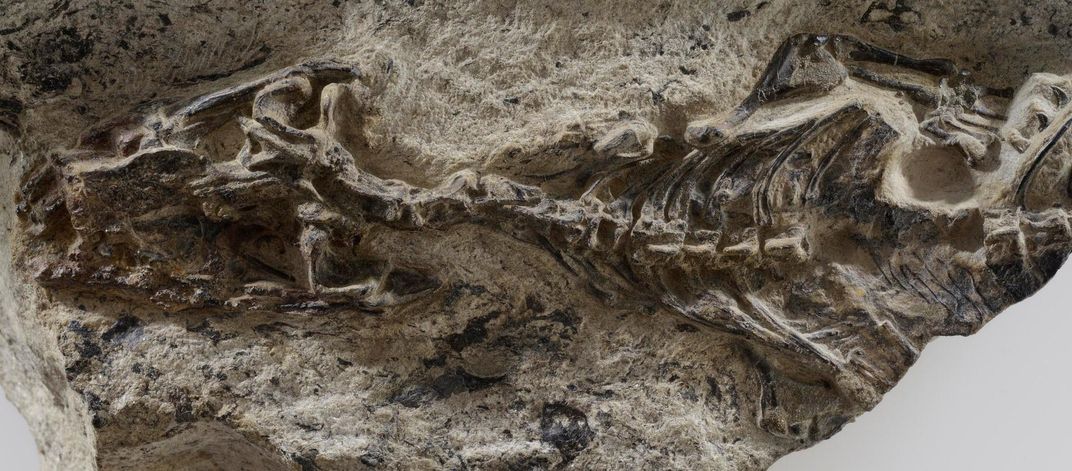Oldest Lizard Fossil Shows These Reptiles Are The Ultimate Survivors
The 250-million-year-old specimen from the Alps suggests that lizards evolved before Earth’s largest mass extinction—and thrived after it
/https://tf-cmsv2-smithsonianmag-media.s3.amazonaws.com/filer/76/c5/76c50566-1b56-4a3d-8b40-0aa6f22b3d70/lizard_illo.jpg)
Around 252 million years ago, an event dubbed the Permo-Triassic extinction event or "The Great Dying" rewrote the story of life on Earth. Researchers aren’t sure exactly what led to this global catastrophe—there’s some evidence it was set off by an asteroid strike or huge volcanic eruptions—but what's clear is that up to 96 percent of marine species and 70 percent of terrestrial vertebrates said bye-bye.
Until recently, it was believed that the ancestors of modern day squamate reptiles—which include all lizards, snakes and legless lizards—appeared after this massive die-off, taking advantage of all the unfilled ecological niches. But, as Nicola Davis reports at The Guardian, a new study suggests that squamates actually evolved before The Great Dying and powered through this cataclysmic period. That finding would transform the lizard family tree—and make these scaly creatures the ultimate survivors.
Davis reports that the new research is based on a 240-million-year-old fossil collected from the Dolomites, part of the Italian Alps, by an amateur fossil hunter in the early 2000s. Researchers could never figure out where the small, lizard-like reptile fit in the evolutionary tree. According to a press release for the study in the journal Nature, paleontologists have now taken a fresh look at the three-inch creature using CT scans to create 3D images of rock-encased animal.
Sarah Kaplan at The Washington Post reports that those scans revealed details of the brain case, collar bone and wrists unique to squamate lizards, as well as bones that survive today in modern lizards as reduced vestigial structures.
The team also spent 400 days examining 150 specimens of other lizard-like creatures held in fossil collections around the world, and constructed the most detailed DNA family tree of living squamates (the word squamate, by the way comes from from Latin squama, or "scale"). They concluded the fossil is the oldest squamate ever discovered, and named it Megachirella wachtleri.
“The specimen is 75 million years older than what we thought were the oldest fossil lizards in the entire world and provides valuable information for understanding the evolution of both living and extinct squamates,” lead author of the study Tiago Simões of the University of Alberta says in the release.
That detailed DNA set and the Megachirella specimen are now allowing researchers to untangle the lizard family tree. “For the first time, having that information with this highly expanded data set, now it became possible to actually assess the relationship of not only this species but also of other species of reptiles,” Simões tells Kaplan.

Ruth Shuster at Haaretz reports that the data settles a long-simmering debate in reptile evolution, by showing that geckoes split from the common ancestor of all lizards before iguanas. Snakes split off from burrowing lizards likely sometime in the Jurassic period.
One of the most impressive aspects of Megachirella, or at least other similar proto-lizard species, is that it survived at all. The fact that early lizards made it through the Great Dying means they were made of tough stuff, or were small enough to avoid the fate of larger vertebrates. ““The Permo-Triassic extinction event was a dangerous time to be alive,” David Martill, a paleobiologist at the University of Portsmouth who wasn't involved in the study tells Davis. “Not much escaped its deathly touch.”
Evolution, however, is the flip side of extinction, co-author Massimo Bernardi of the University of Bristol tells Davis. After the extinction event, the lizards found a new world with less competition and fewer predators, which led to a burst of reptile diversification. Squamates "were actually there before the extinction, they went through [it] in some way, and they took the opportunities that opened up just after the extinction,” says Bernardi.
Kaplan reports that there are over 70 million years between Megachirella and the next known lizard fossil, which is more time than there is between humans and the dinosaurs. But there are clues to how this particular little Mega died. About 250 million years ago, the Dolomites were islands with sand beaches. It’s possible that the lizard was caught up by a thunderstorm, since it was found in a fossilized layer containing plant debris that was swept out to sea.
Which is probably a better way to go than getting fried by an asteroid, anyway.